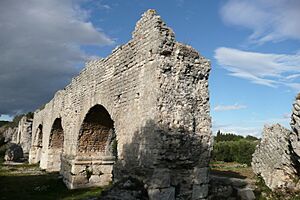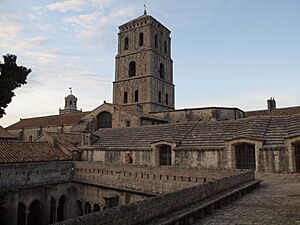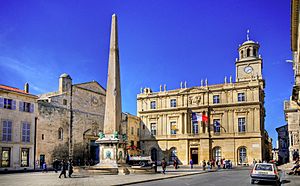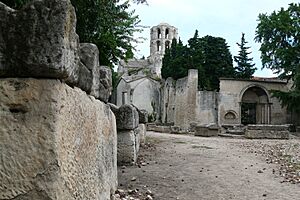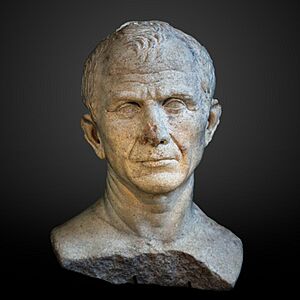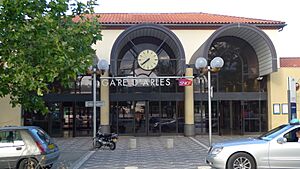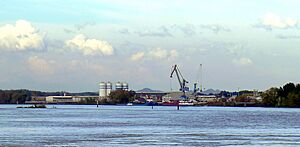Arles facts for kids
Quick facts for kids
Arles
Arle (Occitan)
|
|||
|---|---|---|---|
|
Subprefecture and commune
|
|||

Aerial view of Arles
|
|||
|
|||
| Country | France | ||
| Region | Provence-Alpes-Côte d'Azur | ||
| Department | Bouches-du-Rhône | ||
| Arrondissement | Arles | ||
| Canton | Arles | ||
| Intercommunality | Arles-Crau-Camargue-Montagnette | ||
| Area
1
|
758.93 km2 (293.02 sq mi) | ||
| Population
(2021)
|
50,415 | ||
| • Density | 66.4291/km2 (172.0505/sq mi) | ||
| Time zone | UTC+01:00 (CET) | ||
| • Summer (DST) | UTC+02:00 (CEST) | ||
| INSEE/Postal code |
13004 /13200
|
||
| Elevation | 0–57 m (0–187 ft) (avg. 10 m or 33 ft) |
||
| 1 French Land Register data, which excludes lakes, ponds, glaciers > 1 km2 (0.386 sq mi or 247 acres) and river estuaries. | |||
Arles is a historic city and commune located in the South of France. It's part of the Bouches-du-Rhône department in the Provence-Alpes-Côte d'Azur region. Arles is known for its long history, especially its importance during Roman times.
A large part of the Camargue, which is France's biggest wetland area, is found within Arles' territory. This makes Arles the largest commune in mainland France by land area. The city's land size is similar to that of Singapore.
The Roman and Romanesque Monuments of Arles are so important that UNESCO listed them as World Heritage Sites in 1981. This shows how much history is packed into this city.
Arles is also famous for being home to many artists, including Pablo Picasso and Paul Gauguin. The Dutch painter Vincent van Gogh lived here from 1888 to 1889. During his time in Arles, he created over 300 paintings and drawings. Today, an international photography festival is held in the city every year.
Contents
- What's in a Name?
- Exploring Arles' Geography
- Arles Through Time
- Arles' Climate
- Arles' Population Over Time
- Top Sights in Arles
- Amazing Archaeology Discoveries
- Sports in Arles
- Arles' Culture and Arts
- Arles' Economy
- Getting Around Arles
- Famous People from Arles
- Sister Cities
- Arles in Pop Culture
- See also
What's in a Name?
The name Arles comes from the ancient word Arelate. This word likely meant 'by the marsh' or 'in front of the marsh' in an old language called Gaulish. This makes sense because Arles is located near wetlands.
Exploring Arles' Geography
The Rhône river splits into two branches just before Arles, creating the Camargue delta. Because a large part of the Camargue is within Arles' borders, the city's total area is huge. It's more than seven times the size of Paris!
Even though it's very large, Arles has a population of just over 50,000 people. Besides the main city, the commune of Arles includes several smaller towns and villages. These include Albaron, Mas-Thibert, Moulès, Pont-de-Crau, and Salin-de-Giraud.
Arles Through Time
Ancient History of Arles
People have lived in the Arles area since about 800 BC. The Ligures and later the Celts were among the first groups here. The city then became an important trading port for the Phoenicians.
The Romans took control of Arles in 123 BC and made it a major city. They even built a canal to connect it to the Mediterranean Sea. Arles became a rival to Massalia (Marseille), another important port.
Arles supported Julius Caesar during a civil war. When Caesar won, he rewarded Arles by giving it some of Massalia's lands. Arles became a special colony for Roman soldiers, especially those from the Sixth Legion. Its full name was Colonia Iulia Paterna Arelatensium Sextanorum.
Arles was a very important city in the Roman province of Gallia Narbonensis. It covered about 40 hectares and had many impressive buildings. These included an amphitheatre, a triumphal arch, a circus, and a theatre. The city also had strong walls around it. Back then, Arles was closer to the sea and served as a big port. Over time, the river brought in silt, filling up the old harbor.
A unique Roman bridge in Arles was not fixed. Instead, it was made of boats, with towers and drawbridges at each end. This design helped it survive the Rhône river's frequent floods. Today, only a modern bridge stands near the old spot.
Arles was most powerful in the 4th and 5th centuries. Roman Emperors often used it as their base for military campaigns. By 395 AD, it became the capital for the western part of the Roman Empire, including Gaul (France), Spain, and Brittany. At this time, about 75,000 to 100,000 people lived in Arles.
Emperor Constantine I loved Arles and built baths there, which you can still see today. His son, Constantine II, was born in Arles.
Arles also became a famous cultural and religious center. Important church leaders, like Saint Trophimus and Saint Hilarius, were bishops here. Even when the city faced challenges from invading groups, Arles remained a significant religious place. It hosted important church meetings called councils for hundreds of years.
Roman Aqueduct and Mill
Near Arles, you can find the remains of the Barbegal aqueduct and mill. This was a huge Roman watermill complex. It's often called "the greatest known concentration of mechanical power in the ancient world".
The mill had 16 water wheels built into a steep hillside. Water from two aqueducts powered these wheels. The remains of the water channels and buildings are still visible. This mill likely operated for about 200 years, from the late 1st century to the late 3rd century.
Experts believe these mills could produce about 4.5 tons of flour per day. This was enough to feed about 12,000 people in Arles at that time. The Romans knew a lot about watermills, and this complex shows their advanced engineering skills.
Arles in the Middle Ages
In 735, Saracens (Muslims from Spain) took control of Arles. However, Charles Martel attacked and recaptured the city a year later.
In 855, Arles became the capital of a Frankish Kingdom of Burgundy. This kingdom included parts of Burgundy and Provence. But the area often faced attacks from Saracen and Viking raiders.
Later, in 933, the two kingdoms of Burgundy merged into a new Kingdom of Burgundy-Arles. In 1032, this kingdom was inherited by the Holy Roman Emperor. Over time, most of its territory became part of France. During these difficult times, the amphitheatre was turned into a fortress. A small walled town was even built inside it.
Arles became important again in the 12th century. In 1178, the Holy Roman Emperor Frederick Barbarossa was crowned here. In the 12th century, Arles became a free city. It was governed by an elected leader called a podestat. This status lasted until the French Revolution in 1789.
Modern Arles
Arles remained an important port on the Rhône river for many years. However, in the 19th century, the rise of railways reduced river trade. This caused the city to become less prominent.
This quieter atmosphere made Arles a good place for the famous painter Vincent van Gogh. He arrived in Arles in February 1888. He was captivated by the landscapes of Provence and created over 300 paintings and drawings here. Many of his most famous works, like The Night Cafe and Yellow Room, were painted in Arles.
During his time in Arles, Van Gogh struggled with his mental health. In December 1888, he had a serious incident involving his ear. This led to him staying in the Old Hospital of Arles. In May 1889, he chose to leave Arles for a hospital in nearby Saint-Rémy-de-Provence.
Jewish History in Arles
Arles had a significant and well-known Jewish community from Roman times until the late 15th century. Some stories say the first Jews came to Arles after Jerusalem fell to the Romans. However, the first clear records of Jews in Arles are from the 5th century, when a strong community already existed.
Arles was an important meeting point for Jewish people because it was a port city and close to Spain and other parts of Europe. It played a big role in the work of the Hachmei Provence, a group of famous Jewish scholars and philosophers during the Middle Ages.
The community lived relatively peacefully for a long time. However, in the late 15th century, they were forced to leave the city and never returned as a community. Today, you can find Jewish archaeological items and old texts from Arles in the local museum.
Arles' Climate
Arles has a hot summer Mediterranean climate. This means it has warm and fairly dry summers, with average temperatures between 22°C and 24°C. Winters are cool to mild, with an average temperature of about 7°C.
The city is often affected by the mistral, a cold wind that can cause sudden frosts, especially in winter. Rainfall is spread out from September to May, and the summer dry period is not as strong as in some other Mediterranean areas.
| Climate data for Arles (1991–2020 averages, extremes 1963–present) | |||||||||||||
|---|---|---|---|---|---|---|---|---|---|---|---|---|---|
| Month | Jan | Feb | Mar | Apr | May | Jun | Jul | Aug | Sep | Oct | Nov | Dec | Year |
| Record high °C (°F) | 21.0 (69.8) |
23.1 (73.6) |
25.7 (78.3) |
29.3 (84.7) |
33.0 (91.4) |
42.8 (109.0) |
37.7 (99.9) |
38.7 (101.7) |
33.8 (92.8) |
31.5 (88.7) |
25.0 (77.0) |
20.0 (68.0) |
42.8 (109.0) |
| Mean daily maximum °C (°F) | 11.3 (52.3) |
12.5 (54.5) |
16.2 (61.2) |
18.9 (66.0) |
22.8 (73.0) |
27.1 (80.8) |
29.8 (85.6) |
29.6 (85.3) |
25.3 (77.5) |
20.7 (69.3) |
15.2 (59.4) |
11.9 (53.4) |
20.1 (68.2) |
| Daily mean °C (°F) | 7.3 (45.1) |
8.0 (46.4) |
11.2 (52.2) |
13.8 (56.8) |
17.6 (63.7) |
21.5 (70.7) |
23.9 (75.0) |
23.7 (74.7) |
19.8 (67.6) |
16.2 (61.2) |
11.2 (52.2) |
7.9 (46.2) |
15.2 (59.4) |
| Mean daily minimum °C (°F) | 3.4 (38.1) |
3.4 (38.1) |
6.1 (43.0) |
8.7 (47.7) |
12.4 (54.3) |
16.0 (60.8) |
18.0 (64.4) |
17.7 (63.9) |
14.4 (57.9) |
11.6 (52.9) |
7.3 (45.1) |
4.0 (39.2) |
10.3 (50.5) |
| Record low °C (°F) | −10.6 (12.9) |
−12.0 (10.4) |
−7.3 (18.9) |
−1.7 (28.9) |
2.2 (36.0) |
6.0 (42.8) |
9.7 (49.5) |
8.5 (47.3) |
5.5 (41.9) |
0.3 (32.5) |
−7.4 (18.7) |
−6.4 (20.5) |
−12.0 (10.4) |
| Average precipitation mm (inches) | 53.5 (2.11) |
33.3 (1.31) |
33.9 (1.33) |
57.3 (2.26) |
40.1 (1.58) |
27.0 (1.06) |
12.9 (0.51) |
26.9 (1.06) |
83.7 (3.30) |
80.9 (3.19) |
76.5 (3.01) |
43.6 (1.72) |
569.6 (22.43) |
| Average precipitation days (≥ 1.0 mm) | 5.1 | 4.2 | 4.5 | 5.6 | 4.8 | 2.9 | 2.0 | 2.4 | 4.8 | 5.7 | 7.0 | 5.4 | 54.3 |
| Source: Météo France | |||||||||||||
Arles' Population Over Time
The population numbers below show how many people have lived in the commune of Arles over the years. Keep in mind that the size of the commune changed a bit in 1904 and 1925 when some parts became new communes.
| Historical population | |||||||||||||||||||||||||||||||||||||||||||||||||||||||||||||||||||||||||||||||||||||||||||||||||||||||||||||||||||
|---|---|---|---|---|---|---|---|---|---|---|---|---|---|---|---|---|---|---|---|---|---|---|---|---|---|---|---|---|---|---|---|---|---|---|---|---|---|---|---|---|---|---|---|---|---|---|---|---|---|---|---|---|---|---|---|---|---|---|---|---|---|---|---|---|---|---|---|---|---|---|---|---|---|---|---|---|---|---|---|---|---|---|---|---|---|---|---|---|---|---|---|---|---|---|---|---|---|---|---|---|---|---|---|---|---|---|---|---|---|---|---|---|---|---|---|
|
|
||||||||||||||||||||||||||||||||||||||||||||||||||||||||||||||||||||||||||||||||||||||||||||||||||||||||||||||||||
| Source: EHESS and INSEE (1968-2017) | |||||||||||||||||||||||||||||||||||||||||||||||||||||||||||||||||||||||||||||||||||||||||||||||||||||||||||||||||||
Top Sights in Arles
Arles has many important Roman ruins. Most of them are part of the UNESCO World Heritage Sites. These include:
- The Roman Theatre of Arles
- The arena or amphitheatre
- The Alyscamps (an ancient Roman burial ground)
- The Thermae of Constantine (Roman baths)
- The cryptoporticus (underground galleries)
- Arles Obelisk
- Barbegal aqueduct and mill
The Church of St. Trophime is a beautiful example of Romanesque architecture. Its entrance shows a detailed carving of the Last Judgment, and the columns in its cloister are also famous.
The city also has several museums. The Musée de l'Arles et de la Provence antiques has one of the best collections of Roman sarcophagi (stone coffins) outside of Rome. Other museums include the Musée Réattu and the Museon Arlaten.
The courtyard of the Old Arles hospital, now called "Espace Van Gogh," is a place linked to Vincent van Gogh's time in the city. The LUMA Tower is a modern, tall building that is part of the LUMA Arles arts center.
Amazing Archaeology Discoveries
In 2007, divers found a life-sized marble bust of an important Roman person in the Rhône river near Arles. They also found smaller statues of Marsyas and the god Neptune.
The larger bust was thought to be from 46 BC. Because it showed an older person with wrinkles, and because Julius Caesar founded a colony in Arles around that time, some archaeologists believed it was a portrait of Caesar. France's Minister of Culture even announced that it might be the oldest known image of Caesar.
However, other historians and archaeologists disagreed. They pointed out that the bust didn't look like Caesar's images on coins from his lifetime. They also suggested the bust might be from a later period. The debate continues, showing how exciting and challenging archaeology can be!
Sports in Arles
AC Arles-Avignon was a professional French football (soccer) team from Arles. They used to play in the fourth division of French football. The team was dissolved in 2016. They played their games at the Parc des Sports.
Arles' Culture and Arts
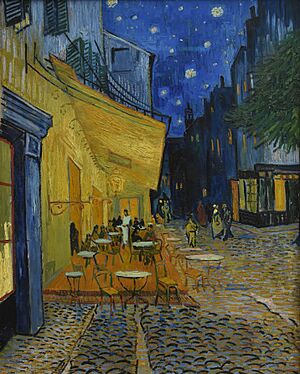
Arles is a hub for culture and arts. The famous Rencontres d'Arles photography festival happens here every year. The French national school of photography is also located in the city.
Many cultural organizations have a presence in Arles, including the LUMA Foundation and the Fondation Vincent van Gogh Arles. You can also find many art galleries throughout the city.
Bullfights are held in the amphitheatre. There are two main types:
- Courses camarguaises: In this Provençal style, the bull is not harmed. Athletes try to remove a tassel from the bull's horn.
- Corridas: These are Spanish-style bullfights where the bulls are killed. These happen during the feria (festival) every Easter and in early September. Before these fights, there's an encierro (bull-running) in the streets.
Parts of several movies, like Ronin and At Eternity's Gate, were filmed in Arles.
European Capital of Culture
Arles played a big role in Marseille-Provence 2013. This was a year-long series of cultural events held in the region when it was named the European Capital of Culture for 2013. Arles hosted part of the opening ceremony and opened a new section of its ancient history museum as part of the celebrations.
Arles' Economy
Arles has a large open-air street market. It's a major market in the region and takes place on Saturday and Wednesday mornings.
Getting Around Arles
The Gare d'Arles railway station connects the city to other major places like Avignon, Marseille, and Paris.
Arles doesn't have its own commercial airport. However, you can fly into Marseille Provence, which is about an hour's drive away.
The A54 autoroute is a toll motorway that passes by Arles. It connects Salon-de-Provence with Nîmes.
The Rhône river is an important transport route. It connects the inland Rhône-Alpes region with the Mediterranean Sea. The Port of Arles is a major place where goods are transferred between river, rail, and road transport. In 2013, it handled about 450,000 tons of goods.
Famous People from Arles
Many notable people have connections to Arles:
- Jeanne Calment (1875–1997), the oldest person ever whose age was officially recorded. She lived to be 122 years old and was born, lived, and died in Arles.
- Vincent van Gogh (1853–1890), the famous Dutch painter, lived here from 1888 to 1889.
- Frédéric Mistral (1830–1914), a well-known Provençal poet, was born near Arles.
- Nicolas Reyes, a musician from the Gipsy Kings.
- Christian Lacroix (born 1951), a famous fashion designer.
- Djibril Cissé (born 1981), a footballer.
- Saint Caesarius of Arles, an important bishop in the 5th and 6th centuries.
Sister Cities
Arles is twinned with these cities around the world:
 Fulda, Germany
Fulda, Germany Jerez de la Frontera, Spain
Jerez de la Frontera, Spain Kalymnos, Greece
Kalymnos, Greece Pskov, Russia
Pskov, Russia Sagne, Mauritania
Sagne, Mauritania Vercelli, Italy
Vercelli, Italy Verviers, Belgium
Verviers, Belgium Wisbech, England, United Kingdom
Wisbech, England, United Kingdom York, United States
York, United States George Town, Malaysia
George Town, Malaysia
Arles in Pop Culture
The colosseum in Arles was used as a setting for some exciting scenes in the 1998 film Ronin.
See also
 In Spanish: Arlés para niños
In Spanish: Arlés para niños








